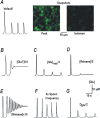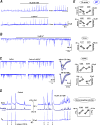Regenerative glutamate release in the hippocampus of Rett syndrome model mice
- PMID: 30256804
- PMCID: PMC6157837
- DOI: 10.1371/journal.pone.0202802
Regenerative glutamate release in the hippocampus of Rett syndrome model mice
Abstract
Excess glutamate during intense neuronal activity is not instantly cleared and may accumulate in the extracellular space. This has various long-term consequences such as ectopic signaling, modulation of synaptic efficacy and excitotoxicity; the latter implicated in various neurodevelopmental and neurodegenerative diseases. In this study, the quantitative imaging of glutamate homeostasis of hippocampal slices from methyl-CpG binding protein 2 knock-out (Mecp2-/y) mice, a model of Rett syndrome (RTT), revealed unusual repetitive glutamate transients. They appeared in phase with bursts of action potentials in the CA1 neurons. Both glutamate transients and bursting activity were suppressed by the blockade of sodium, AMPA and voltage-gated calcium channels (T- and R-type), and enhanced after the inhibition of HCN channels. HCN and calcium channels in RTT and wild-type (WT) CA1 neurons displayed different voltage-dependencies and kinetics. Both channels modulated postsynaptic integration and modified the pattern of glutamate spikes in the RTT hippocampus. Spontaneous glutamate transients were much less abundant in the WT preparations, and, when observed, had smaller amplitude and frequency. The basal ambient glutamate levels in RTT were higher and transient glutamate increases (spontaneous and evoked by stimulation of Schaffer collaterals) decayed slower. Both features indicate less efficient glutamate uptake in RTT. To explain the generation of repetitive glutamate spikes, we designed a novel model of glutamate-induced glutamate release. The simulations correctly predicted the patterns of spontaneous glutamate spikes observed under different experimental conditions. We propose that pervasive spontaneous glutamate release is a hallmark of Mecp2-/y hippocampus, stemming from and modulating the hyperexcitability of neurons.
Conflict of interest statement
The authors have declared that no competing interests exist.
Figures








Similar articles
-
CA1 Neurons Acquire Rett Syndrome Phenotype After Brief Activation of Glutamatergic Receptors: Specific Role of mGluR1/5.Front Cell Neurosci. 2018 Oct 17;12:363. doi: 10.3389/fncel.2018.00363. eCollection 2018. Front Cell Neurosci. 2018. PMID: 30386209 Free PMC article.
-
Rescue of hyperexcitability in hippocampal CA1 neurons from Mecp2 (-/y) mouse through surface potential neutralization.PLoS One. 2018 Apr 5;13(4):e0195094. doi: 10.1371/journal.pone.0195094. eCollection 2018. PLoS One. 2018. PMID: 29621262 Free PMC article.
-
Impaired hippocampal Ca2+ homeostasis and concomitant K+ channel dysfunction in a mouse model of Rett syndrome during anoxia.Neuroscience. 2010 Nov 24;171(1):300-15. doi: 10.1016/j.neuroscience.2010.08.031. Epub 2010 Aug 21. Neuroscience. 2010. PMID: 20732392
-
Exploring the possible link between MeCP2 and oxidative stress in Rett syndrome.Free Radic Biol Med. 2015 Nov;88(Pt A):81-90. doi: 10.1016/j.freeradbiomed.2015.04.019. Epub 2015 May 8. Free Radic Biol Med. 2015. PMID: 25960047 Review.
-
The relationship of Rett syndrome and MECP2 disorders to autism.Dialogues Clin Neurosci. 2012 Sep;14(3):253-62. doi: 10.31887/DCNS.2012.14.3/jneul. Dialogues Clin Neurosci. 2012. PMID: 23226951 Free PMC article. Review.
Cited by
-
Instant activation of TRP channels by NH4 + promotes neuronal bursting and glutamate spikes in CA1 neurons.Curr Res Physiol. 2020 Jun 27;3:20-29. doi: 10.1016/j.crphys.2020.05.002. eCollection 2020 Dec. Curr Res Physiol. 2020. PMID: 34746817 Free PMC article.
-
Insights into the structure and function of the hippocampus: implications for the pathophysiology and treatment of autism spectrum disorder.Front Psychiatry. 2024 Apr 23;15:1364858. doi: 10.3389/fpsyt.2024.1364858. eCollection 2024. Front Psychiatry. 2024. PMID: 38716113 Free PMC article. Review.
-
Excitation and Inhibition Imbalance in Rett Syndrome.Front Neurosci. 2022 Feb 18;16:825063. doi: 10.3389/fnins.2022.825063. eCollection 2022. Front Neurosci. 2022. PMID: 35250460 Free PMC article. Review.
-
Dendrimer-conjugated glutaminase inhibitor selectively targets microglial glutaminase in a mouse model of Rett syndrome.Theranostics. 2020 Apr 27;10(13):5736-5748. doi: 10.7150/thno.41714. eCollection 2020. Theranostics. 2020. PMID: 32483415 Free PMC article.
-
CA1 Neurons Acquire Rett Syndrome Phenotype After Brief Activation of Glutamatergic Receptors: Specific Role of mGluR1/5.Front Cell Neurosci. 2018 Oct 17;12:363. doi: 10.3389/fncel.2018.00363. eCollection 2018. Front Cell Neurosci. 2018. PMID: 30386209 Free PMC article.
References
Publication types
MeSH terms
Substances
LinkOut - more resources
Full Text Sources
Other Literature Sources
Medical
Molecular Biology Databases
Miscellaneous

